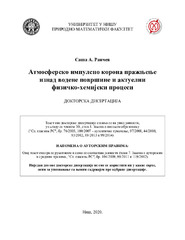Приказ основних података о дисертацији
Atmosfersko impulsno korona pražnjenje iznad vodene površine i aktuelni fizičko-hemijski procesi
| dc.contributor.advisor | Maluckov, Čedomir A. | |
| dc.contributor.other | Ristić, Goran S. | |
| dc.contributor.other | Karamarković, Jugoslav P. | |
| dc.creator | Rančev, Saša | |
| dc.date.accessioned | 2022-10-12T14:36:08Z | |
| dc.date.available | 2022-10-12T14:36:08Z | |
| dc.date.issued | 2021-03-17 | |
| dc.identifier.uri | http://eteze.ni.ac.rs/application/showtheses?thesesId=8489 | |
| dc.identifier.uri | https://fedorani.ni.ac.rs/fedora/get/o:1756/bdef:Content/download | |
| dc.identifier.uri | https://plus.cobiss.net/cobiss/sr/sr/bib/36085513 | |
| dc.identifier.uri | https://nardus.mpn.gov.rs/handle/123456789/20731 | |
| dc.description.abstract | Many industries generate wastewaters which contain various organic pollutants harmful to the environment, which can not be effectively removed by standard procedures. They can be degraded by the advanced oxidation processes, which include, among the others, various plasma processes. Among them, the atmospheric pressure pulsating corona discharge in gas above the water phase has a great potential. The subject of this dissertation is a detailed examination of basic processes of the pulsating positive corona discharge in gas above the solution and corresponding physico-chemical reactions. The aim is to set up highly effective system for the stable organic pollutants degradation. The reactor which operates without sparks at much higher frequencies than similar ones in the air at atmospheric pressure was constructed. This enabled to avoid the expensive complicated systems and vacuum pumps. During the operation, constant ion wind improves the mixing of liquid and maintains it cold, which further improves degradation rate, as well as energy efficiency. Degradation of anthraquinone dye Reactive Blue 19 was done by OH radicals, generated by decomposition of corona–generated hydrogen peroxide in water phase. Degradation rate increases with the increase of discharge current density, and it decreases with the increase of initial dye concentration. Degradation is the fastest at neutral pH. The optimal degradation parameters are determined. Decolorization reaction follows the pseudo–first order kinetics. High mineralization degree (over 85%) and high energy efficiency of 2,45 g/kWh for a solution concentration of 50mg/l. There is no need for addition of chemicals. Degradation rate, mineralization degree and energy efficiency increase in the presence of catalyst, which is excited by the corona generated particles and UV radiation of a high enough energy. The system posses a potential for the industrial scale application. | en |
| dc.format | application/pdf | |
| dc.language | sr | |
| dc.publisher | Универзитет у Нишу, Природно-математички факултет | sr |
| dc.rights | openAccess | en |
| dc.rights.uri | https://creativecommons.org/licenses/by-nc-nd/4.0/ | |
| dc.source | Универзитет у Нишу | |
| dc.subject | Korona | sr |
| dc.subject | Corona | en |
| dc.subject | vodena površina | sr |
| dc.subject | reaktor | sr |
| dc.subject | obezbojavanje | sr |
| dc.subject | katalizatori | sr |
| dc.subject | jonski vetar | sr |
| dc.subject | water surface | en |
| dc.subject | reactor | en |
| dc.subject | decolorization | en |
| dc.subject | catalysts | en |
| dc.subject | ion wind | en |
| dc.subject | pulsating | en |
| dc.title | Atmosfersko impulsno korona pražnjenje iznad vodene površine i aktuelni fizičko-hemijski procesi | sr |
| dc.type | doctoralThesis | |
| dc.rights.license | BY-NC-ND | |
| dc.identifier.fulltext | http://nardus.mpn.gov.rs/bitstream/id/146308/Rancev_Sasa_A.pdf | |
| dc.identifier.fulltext | http://nardus.mpn.gov.rs/bitstream/id/146307/Doctoral_thesis_12619.pdf | |
| dc.identifier.rcub | https://hdl.handle.net/21.15107/rcub_nardus_20731 |



